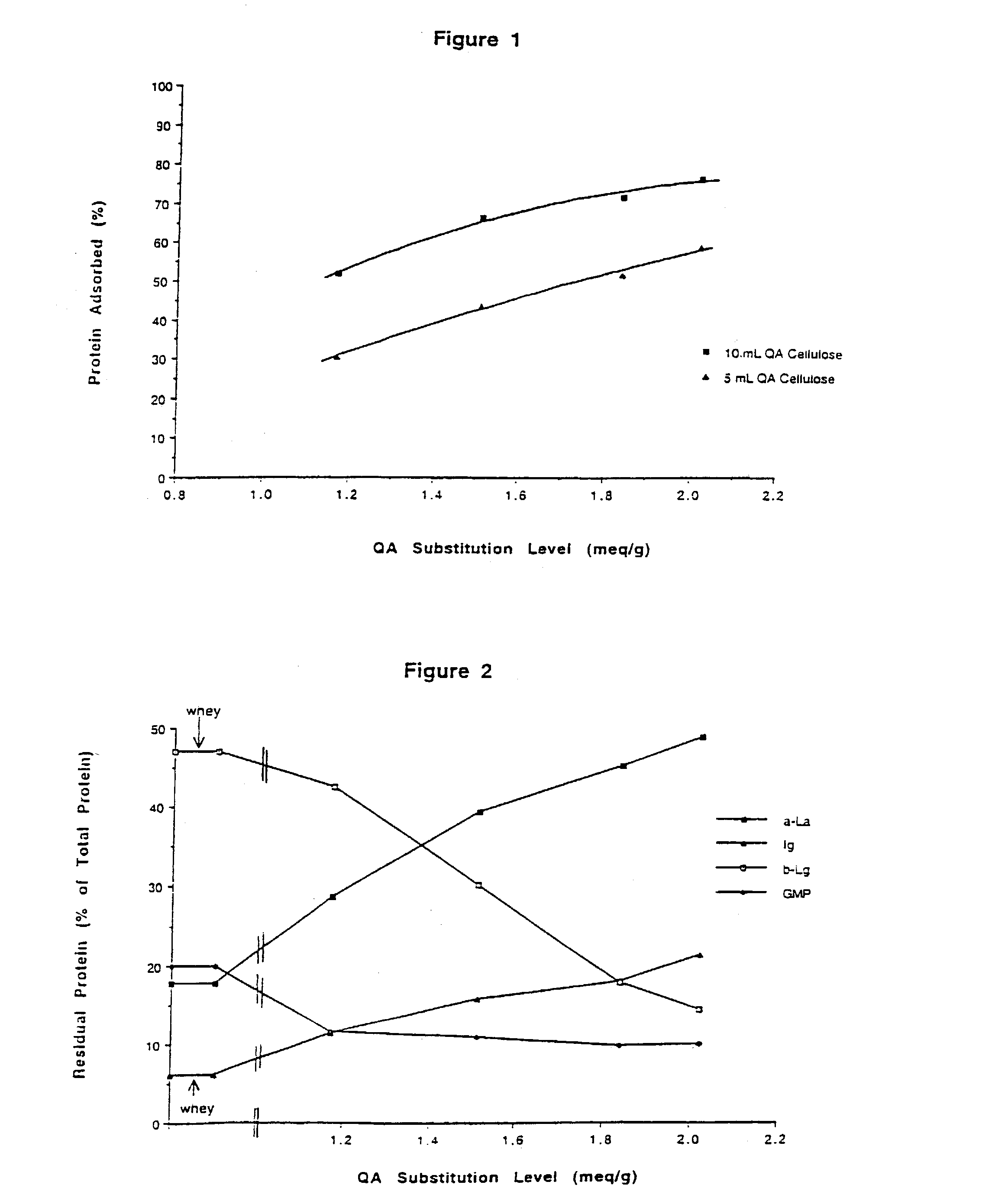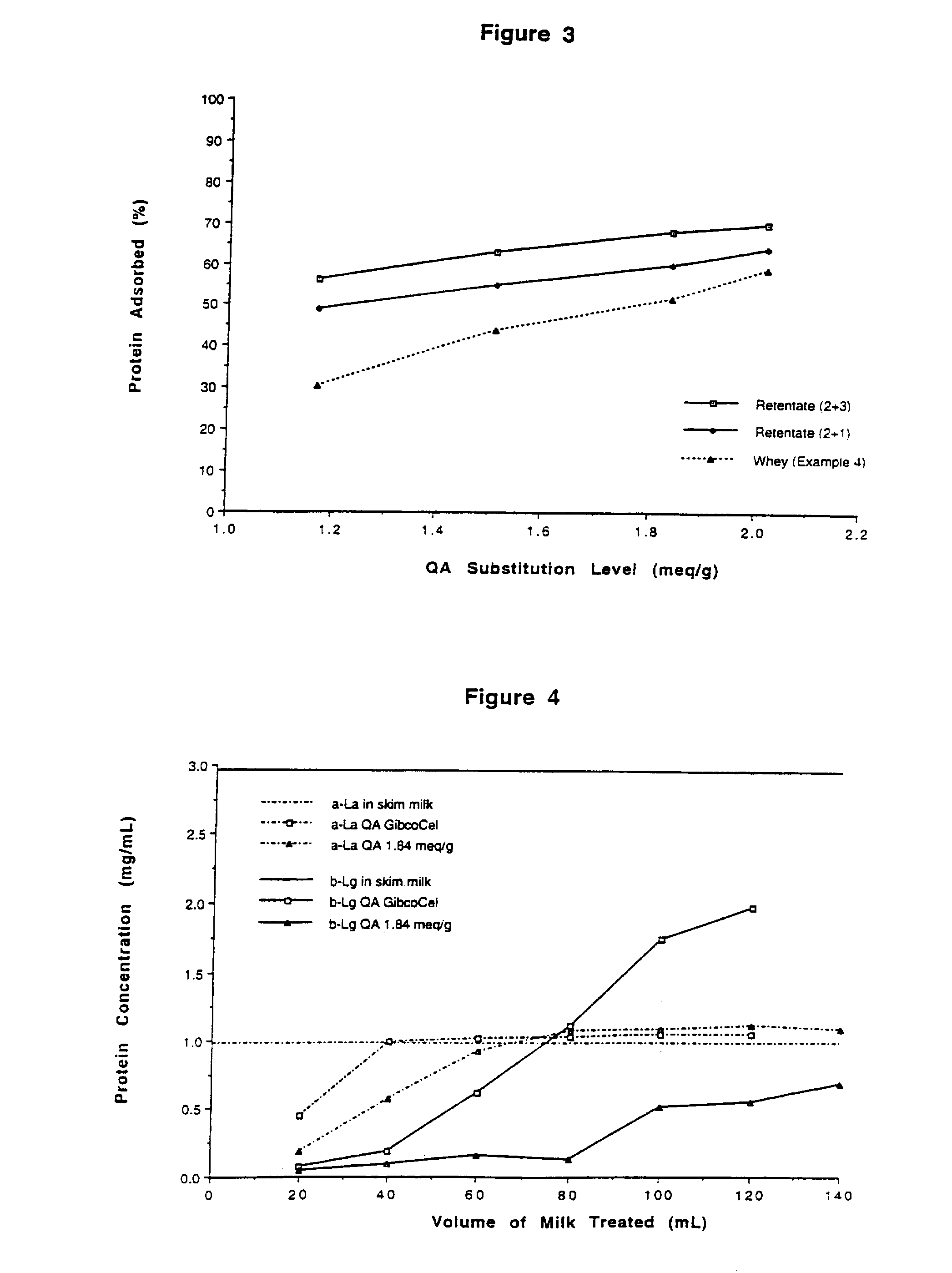Process for separation of whey proteins using a novel anion exchanger
a technology of anion exchanger and whey protein, which is applied in the direction of ion exchanger, carrier-bound/immobilised peptide, food ingredients, etc., can solve the problems of difficult to recover whey proteins by ion exchange industrially, weak mechanical properties, and none of these are suitable for large-scale industrial us
- Summary
- Abstract
- Description
- Claims
- Application Information
AI Technical Summary
Problems solved by technology
Method used
Image
Examples
example 1
[0092]QA GibcoCel™ HG2 (1.17 meq / g), an anion exchanger made from granular regenerated cellulose, was obtained from Life Technologies Ltd, Auckland, New Zealand. It was suspended in water and then collected on a sintered glass filter where it was washed with 1 M hydrochloric acid, water, 1 M sodium hydroxide and finally de-ionised water. It was then drained of excess water by vacuum filtration. This QA cellulose in its hydroxide form was then further alkylated to raise the density of positively charged QA groups.
[0093]The QA GibcoCel[OH−] was made up to a thick slurry by the addition of water and 30% (w / v) aqueous sodium hydroxide. The mixture was chilled before adding (3-chloro-2-hydroxypropyl)trimethylammonium chloride (60 wt. % solution in water). The amounts used are shown in Table 1. These ingredients were mixed as a slurry for 17 hours at room temperature followed by 2 hours at 60 C. The QA cellulose products were collected on filters and washed with water, 1 M hydrochloric ac...
example 2
(a) Preparation of Hydroxypropyl Cellulose (HP-Cellulose)
[0098]The same Grade 2 (150–250 mm) granular regenerated cellulose as used to make the commercially available anion exchanger QA GibcoCel used in Example 1, was obtained from Life Technologies Ltd, Auckland, New Zealand. A sample (10 g) of this was mixed in a stainless steel vessel with cold 30% (w / v) aqueous sodium hydroxide (15 mL) and 0.7 mL of epichlorohydrin dissolved in 5 mL of propylene oxide. The mixture was stirred thoroughly until the cellulose had finished swelling and all the liquid had been absorbed. The reaction vessel was then sealed and placed in a water bath at room temperature and heated to 50° C. over 30 minutes. After one hour at 50° C. the reaction vessel was cooled and the damp, friable cellulose powder (cross-linked and hydroxypropylated cellulose, HP-cellulose) was treated further without washing.
(b) Alkylation with (3-chloro-2-hydroxypropyl)trimethylammonium chloride (CHPTAC)
[0099]After chilling the re...
example 3
[0100]A sample of QA cellulose (2.08 meq / g) from Example 2 was further processed in place of QA GibcoCel (1.17 meq / g) as described in Example 1 for preparation #2. Six mL of (3-chloro-2-hydroxypropyl)trimethylammonium chloride was reacted with 45 g of QA cellulose[OH−], 31 mL of water and 5 mL of 30% (w / v) aqueous sodium hydroxide. The product had a substitution level of 2.52 meq / g, and a β-lactoglobulin capacity of 1.96 g / g.
PUM
| Property | Measurement | Unit |
|---|---|---|
| pH | aaaaa | aaaaa |
| pH | aaaaa | aaaaa |
| temperature | aaaaa | aaaaa |
Abstract
Description
Claims
Application Information
 Login to View More
Login to View More - R&D
- Intellectual Property
- Life Sciences
- Materials
- Tech Scout
- Unparalleled Data Quality
- Higher Quality Content
- 60% Fewer Hallucinations
Browse by: Latest US Patents, China's latest patents, Technical Efficacy Thesaurus, Application Domain, Technology Topic, Popular Technical Reports.
© 2025 PatSnap. All rights reserved.Legal|Privacy policy|Modern Slavery Act Transparency Statement|Sitemap|About US| Contact US: help@patsnap.com



